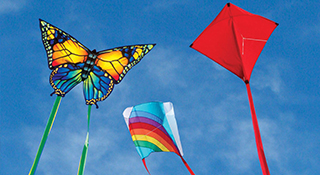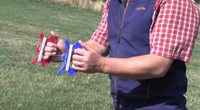FAQ – About Kite Flying + Wind
Where does wind come from?
Differences in temperature vary across the surface of the earth and heat up at different rates. Differences in air temperature creates differences in air pressure and over a distance creates a pressure gradient that makes the wind blow.
Just like an airplane, a bird or a bee, some kites have "wings" to help them fly. Besides wings, what are the other aerodynamic factors at work in kite design?
Well, birds, bees and airplanes all use different aerodynamics. We call the extended flat panels on kites “wings” but most are sails, and like your examples, kites require moving air over the sail to create lift to fly. Thrust, drag and gravity can all affect a kite’s flight. Wind resistance on the kite’s surface (and tail) creates drag. Drag can also result from turbulence behind the kite. Gravity is the downward force created by the weight of the kite and thrust is the power of the wind that creates lift. To fly, a kite needs to have enough lift to overcome gravity and drag. All of these forces - lift, drag, gravity, and the thrust of the wind come together in the kite at a place called the center of pressure. Not surprisingly, that's where you tie your kite string. We call this bridle point, the tow point. By moving the attachment point on the bridle line, it’s possible to change the amount of lift that is created by changing the angle of attack.
What does sail loading mean and how does it affect a kite’s performance?
Sail loading is a ratio that refers to the weight of the kite, in ounces, divided by the area of its sail in square feet. Lower numbers mean that the kite will usually fly in less wind and higher numbers mean that the kite requires more wind to fill the sail and lift the kite into the air. Lighter, smaller kites will have lower sail loading numbers than larger or heavier kites. However, sail loading is only applicable as a general rule, kite design is still a significant factor when determining specific wind ranges.
Is the lift generated by a kite directly proportional to its size, or are there some smaller kites that have better lift than a larger kite?
For a given design of kite, there will be a general increase in lift as the kite increases in size and a decrease of lift as the kite becomes smaller. However, design and angle of attack can change that generalization as well and this reasoning doesn’t take into account the speed of the air moving over the lifting surfaces of the kite. Remember, if the kite has significant ground/forward speed, the lift will dramatically increase.
What is the angle of attack?
The angle of attack refers to the angle of the kite in flight in relation to the wind. Many kites have an adjustable bridle that will allow you to change how much wind hits the sail of the kite or how much spills off in higher or lower winds.
What is the Beaufort Scale?
The Beaufort Scale is a simple way of judging wind speed invented by Admiral Francis Beaufort. By observing how wind affects your surroundings, you can get a general sense of the wind speed. Click here to see the Beaufort Scale
Are there any kite flying safety tips you would recommend?
The most often overlooked aspect of kite safety is wearing gloves. The usual reflex reaction to a burn is to let go of the string. Machismo won't prevent it! Use gardening gloves, sailing gloves, weight-lifting gloves, bike gloves, work gloves, most any kind of gloves -- but wear 'em! We carry a couple of glove options that we think are ideal for kiteflying. Also, make sure you are flying in an open area, away from powerlines, trees, people, etc.
What is the most essential knot for kite flying?
The Larkshead Knot – it can be used to attach a flying line to a snap swivel or your kite, attach line to an anchor, and it’s our preferred method for attaching stunt kite lines to a bridle.
Why do I need a swivel for my single-line kite?
While swivels are not required to fly a single-line kite, they do help you attach your line quickly. You can just keep your flying line attached to the swivel and hook it up to your kite's bridle as needed. The swivel also keeps twists and tangles out of your line.
Why doesn't my stunt kite come with swivels?
Some manufacturers include swivels on the bridles of their stunt kites, but we generally prefer to tie a Lark's Head Bridle Knot to attach lines to a stunt kite. We have found that swivels wear down the bridle rather quickly; to prolong the life of your kite's bridle, it's much better to learn the knot!
Do I need a tail with my kite?
Most kites do not require a tail to fly in their normal wind range. In gusty winds, adding a tail can help to stabilize the kite. Plus, tails always look great! They add drama and color to your flight. Long tube tails trace the path of your stunt kite in the sky for a cool effect and slow the kite down, making it easier to fly. We recommend stunt tails for beginner stunt kites.
How do you feed the line onto the reel evenly when you have a lot of line out and want to pull your kite in?
Keep some tension on the line when winding it in, as loosely wound line tends to tangle. When winding onto a spool with your hand, turn the spool over from time to time and wind in the other direction. This keeps the line from twisting so many times that it tangles. This same rule can apply to winding line in on a reel to keep it evenly distributed. In any case, never struggle to reel in your kite. Reeling in line under strong tension could damage the reel. In strong winds, walk your kite down or pull the line in with your gloved hands, while moving around to avoid piling up line in one place. Then wind the line onto your reel.
Do I need to run with my kite to get it up in the air?
You shouldn't have to run to launch a kite. If you do, then there's probably not enough wind to fly. Running is the hardest way to launch a kite. The uncontrolled tugging on the line makes kites dive and crash. Let the wind and your reel do the work instead.
I've tried to fly my kite several times and it just won't stay in the air. What should I do?
If you have difficulty getting your kite to fly at the same location on multiple attempts, you should always try another location first. Sometimes structures and buildings can block the wind resulting in unstable and turbulent conditions. These variable winds can make an otherwise excellent flying kite perform poorly. If the kite fails to fly at several different locations, double check that you have assembled it correctly and make sure you're flying within the recommended wind range.
I can't seem to fly my diamond kite on days when all my other kites will fly. What am I doing wrong?
There are a few factors contributing to a good flying diamond. First, you usually need more wind than with delta kites. Diamonds have less surface area at the tail of the kite, which is the area that provides the most lift, so diamonds need more wind to get the same amount of lift as a delta in low wind. Second, the dihedral on the back of the diamond must be set at the correct angle. Diamonds are somewhat surprising flyers because they angle away from the wind, more or less cutting through the wind rather than catching it. It might make more sense to have the diamond flat or shaped like a basket to catch more wind, but the design requires the kite angle away from the wind and from you, like a boat going through the water. Third, the bridle on a diamond is sensitive and must be the appropriate lengths and create the proper angles for the kite to have any success flying. If there’s a chance your diamond may be out of adjustment, consult the instructions for your kite or contact us and we can help you. Diamonds are gorgeous fliers, but in spite of their well-known look and reputation, they are not the easiest kites to fly.
Why does my foil sometimes collapse at the edge of the wind window?
Foil kites are completely soft and have no rigid structure. Initially, inflating the sail with wind creates the shape of the kite, but flying conditions can alter the shape. At the edges of the wind window, it is harder for the wind to inflate the sail because of the angle of the vents versus the direction of the wind. This can cause foils to collapse, but multiple bridles and cross-venting can reduce this tendency. Generally speaking, foils collapse when there is not enough wind to inflate the sail.
I'm a beginner and I have already accumulated 4 different lines. How do you keep track of the line strength that your kite should use and the strength of the line that you have on your handles?
The easy answer is to mark the winders or hoops with the line strength. Try a permanent ink marker, or stickers with the test-weight. For stunt kite line, you can sleeve the ends with different colored sleeving – don’t forget which color stands for what strength.
Do I need to do anything special to my kite if I intend to store it for a long period of time?
It is a good idea to let the tension out of your sail so that it does not stretch over time. If you keep your kite in a cool, dry place and out of direct sunlight, it should still be flying high when you're ready to get back into the wind. Also, keep all of your parts for your kite in one place so that they don't get lost over time.


